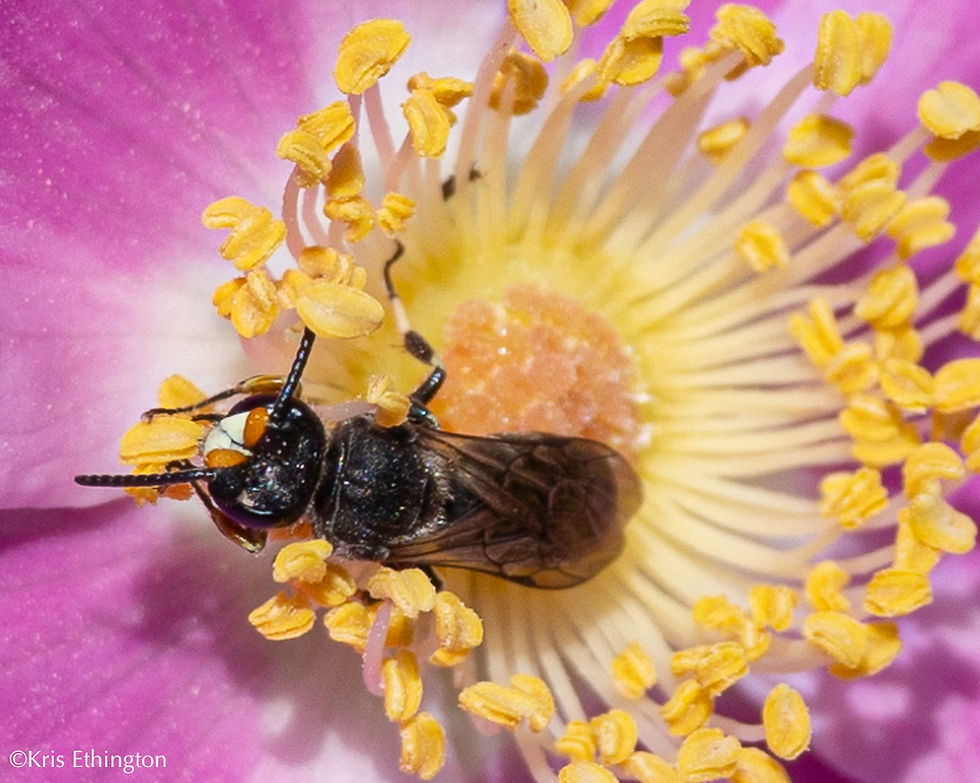The western thistle longhorn bee
- Joe Dlugo

- Jul 25
- 4 min read
Updated: Jul 30

I'll never forget the first time I saw a western thistle longhorn bee (Melissodes rivalis — what a beautiful scientific name, right?). It was July 2018. I had just returned home after a week in Illinois, where I saw longhorn bees with jet-black exoskeletons on tall midwestern prairie blooms. What a contrast from the usual gray-haired longhorns I was used to seeing out west. I wished they lived in Washington.
Just days after, I was in the field with a botanist friend, commenting all day about the intrigue of these robust black bees from far away. I couldn't get them off my mind. When we finished the day back at my garden, what a shock it was to notice an unusual, large black bee on my flowers. Could it be? My wish came true very quickly. I was wholly unaware we had a similar species in the Northwest, and what a thrill to have them in my garden!

If a common name is any indication, these large bees have an unrivaled affinity for thistles. Their scientific name is a bit more puzzling. Melissodes translates to melissa, meaning "bee," and -odes, meaning "resembling"—so essentially "bee-like." The species name rivalis could mean "of the stream" or maybe "dweller of brooks," though I've mostly seen them in dry places. It also might hint at the word "rival." Like many scientific names, there's a mix of poetry and puzzlement.
The females have a bulldog-like stature with patterned blue eyes, and long, brightly colored pollen-carrying hairs on their hind legs (scopae). Think rodeo queen chaps. They nest in the ground near their favorite plants but are also seen on blanketflower, native Helianthus annuus sunflowers, and other large-flowered asteraceae. The males look almost unrelated. They're thinner and longer than the females and full of tannish-gray hair, with green eyes and very long, surprisingly reddish antennae.


These bees are spectacular but rarely seen. Since that first year, I have only had them in my garden two other years. If you use iNaturalist, you'll see just a few sightings in Washington State, on both the west and east sides, and all in the month of July. Here one year, gone the next. Neighboring regions show nearly the same results. Why so spotty? It might be that for all their gregarious features, the untrained eye finds them remarkably similar to bumblebees. So I wonder: are they uncommon, or commonly overlooked?
So how do you keep from missing them? If yours is a picture memory, keep in mind that thistle longhorns have shiny bodies with short, drab yellow hairs on the thorax and no stripes—a color pattern absent in local bumblebees. If you get the field mark of those extra-large pollen pants, you'll be able to spot the thistle longhorn easily from significant distances. If you think more in contexts and behavior, the longhorns tend to "snorkel" through the thistle blooms, with bodies low and heads staying concealed in the pink petals, rarely coming up for air. Bumble bees poke around the thistle, dipping their heads and keeping their backs high.
If you want to find them, be an active mid-summer bee watcher and look for freshly blooming thistles. This means weedy, itchy, old fields with flying cottonballs everywhere. The kinds of places slated to be "developed." Wear pants if you have to bushwhack. The payoff is worth the effort.
If you want to invite them to your garden, it means counter-culturally embracing the glory of thistles, an infamous genera that has been maligned and misunderstood for eons. Spend time watching a thistle in bloom, and you'll see the magic. They are among nature's most extraordinary pollinator plants. Weedy bull thistles are enjoyed and take almost no effort, but there are also many native thistles that can be sown. There are other flowers they enjoy, including the native Columbia blanket flower (Gaillardia), false sunflower (Heliopsis), or Mexican sunflower (Tithonia). I have sourced native blanketflower from Derby Canyon Natives in Peshastin (near Leavenworth) and French's Farm in Lyle (Columbia Gorge). It's likely other Washington native plant nurseries have it as well. It grows great both east and west of the mountains.

Lastly, these bees need good ground to dig in. Their next generation depends on it. Good ground for bee nests is not artificially green lawns sprinkled with fertilizer and herbicide. Good ground is the nostalgic earth below a children's swing set or the dried-out, sandy July lawn where rabbits roam and only dandelions stand. Start walking the same path through your lawn every day for years. In time, that path will become good, sacred ground, a nursery for bees. Work smarter, not harder, and you may gain a delightfully rare neighbor of which few Washington gardeners can claim.
–J




Comments